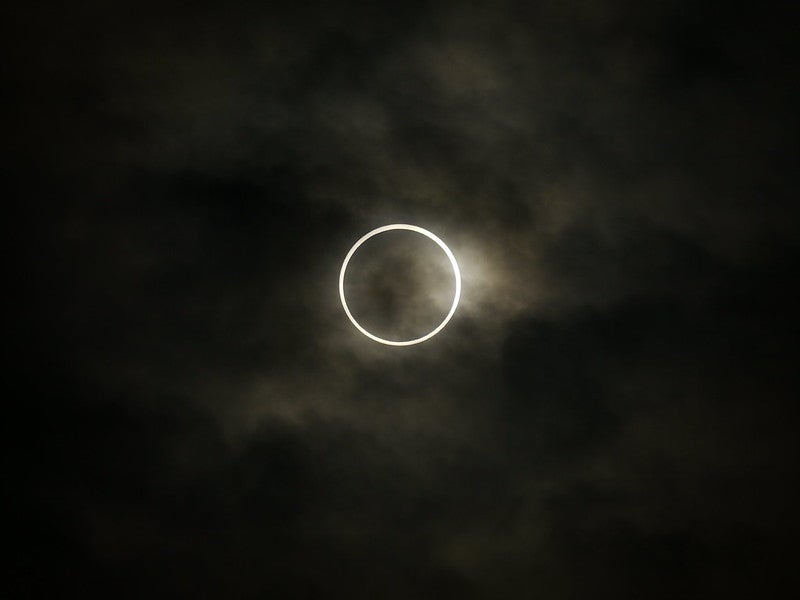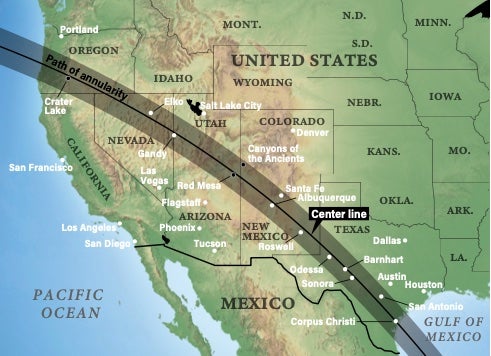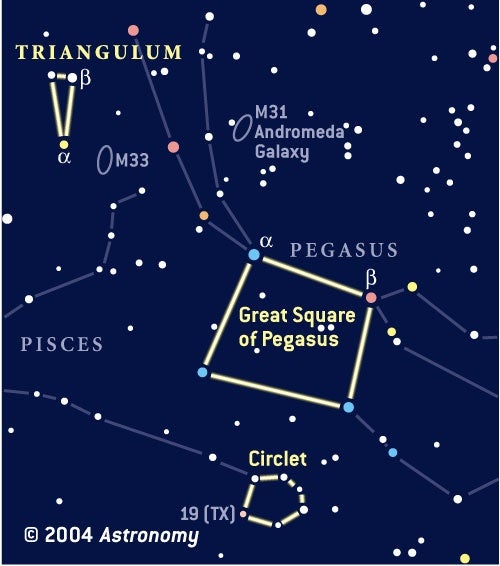
Friday, October 13
In honor of Friday the 13th, we’re looking tonight for NGC 7789, an open cluster in Cassiopeia the Queen. Astronomy columnist Stephen James O’Meara has christened it the Screaming Skull Cluster, though it also goes by a more flowery — literally — name as well: Caroline’s Rose. This is because the cluster was discovered by Caroline Herschel in 1783. This month marks the 240th anniversary of her find.
The magnitude 6.7 cluster is located just less than 3° southwest of Caph, the Queen’s 2nd-magnitude beta star. Caph is easy to find, as it marks the rightmost tip of the famous W-shaped asterism that many observers recognize as Cassiopeia (when the W is right-side up). Spanning about 16′, NGC 7789 is an easy catch in binoculars or any small scope. The cluster is quite rich, containing roughly 1,000 stars; the number you’re able to resolve will depend on your instrument.
Here’s the big question: Does it look like a screaming skull to you? The spooky visage can be tricky to see, but it’s there if you look closely. Some people see the skull facing forward, while others picture it looking to the side.
Sunrise: 7:08 A.M.
Sunset: 4:23 P.M.
Moonrise: 5:58 A.M.
Moonset: 6:03 P.M.
Moon Phase: Waning crescent (1%)
*Times for sunrise, sunset, moonrise, and moonset are given in local time from 40° N 90° W. The Moon’s illumination is given at 12 P.M. local time from the same location.

Saturday, October 14
New Moon occurs at 1:55 P.M. EDT, and with it comes a spectacular show: an annular solar eclipse. Such an eclipse occurs when the Moon passes in front of the Sun, as during a total eclipse — but in this case, the Moon is farther than average from Earth, so its disk is just slightly too small to cover the entire disk of the Sun. This leaves a thin ring of the Sun — often called a ring of fire — visible around the dark outline of the Moon. It also means that the entire eclipse, even for those within the path of annularity, must be viewed with safety equipment such as eclipse glasses or an approved solar filter. At no point during the eclipse should you look at the Sun directly, as this can cause serious and permanent damage to your eyes.
The path of annularity moves southeast across the U.S., from the Pacific Northwest down through Texas toward the Gulf of Mexico. From there, it continues through parts of Mexico, and Central and South America. U.S., observers along the center line will enjoy 4-plus minutes of annularity, with parts of Texas seeing nearly 5 minutes of annularity. The moment of greatest eclipse will occur over the Caribbean Sea. The timing of the eclipse varies with location, so check out our resources below for information on your viewing location’s notable times.
Even if you’re not in the path of annularity, observers across North America, Central America, and much of South America will see a partial eclipse. The percentage of the Sun covered by the Moon will depend on your location — again, remember that no part of this event can be safely viewed without protection.
If you’d like to know more about what you’ll see and when from your location, there are several excellent resources available. Astronomers Without Borders’ One Eclipse App features an easy-to-use interface that includes an eclipse simulator, countdown timer, and interactive map. It costs just $1.99 and half of all revenue from the app’s sale goes directly to supporting Astronomers Without Borders programming.
For those using web browsers, Eclipse2024.org features a page on this weekend’s annular eclipse, where you can find details on eye safety, local circumstances, and an eclipse simulator.
Sunrise: 7:09 A.M.
Sunset: 6:22 P.M.
Moonrise: 6:59 A.M.
Moonset: 6:24 P.M.
Moon Phase: New

Sunday, October 15
Pull out your binoculars or small scope tonight and catch the distant planet Neptune. Today, the ice giant sits just 6′ due north of a magnitude 7.3 field star in Pisces the Fish. It’s a great opportunity to learn how to determine the difference between a distant planet and a star in your eyepiece!
The region is rising as twilight falls, so you don’t need to wait long. Just an hour or two after sunset, look southeast for the Circlet of Pisces, a seven-star asterism located to the lower right (south) of the Great Square of Pegasus. Once you’ve found the Circlet, locate Lambda (λ) Psc, the southeasternmost star in the group. From there, drop 5° south and you’ll land on the pair: magnitude 7.3 HIP 117112, a field star, and slightly fainter magnitude 7.7 Neptune. The two sit in a north-south line. Neptune is the northern of the two points (note that this may not be the “top” point, depending on how your optics flip or rotate images). See if you can discern the planet’s tiny, 2″-wide disk as a “flat” star that might even have a bluish cast. The star to its south will look more like a pinprick than a disk.
As a bonus, slide your gaze back up to Lambda, then look 2° north-northeast of it. Centered in your field will be a ruby-red star: 19 Psc, also known as TX Psc. This 5th-magnitude star is a carbon star whose atmosphere scatters away blue light, giving it a deep red hue.
Sunrise: 7:10 A.M.
Sunset: 6:20 P.M.
Moonrise: 8:03 A.M.
Moonset: 6:47 P.M.
Moon Phase: Waxing crescent (1%)
Monday, October 16
Let’s find the solar system’s other ice giant tonight, as Uranus begins a few-day trek between a line of two widely spaced 7th-mangitude field stars. The distant planet rises within two hours of sunset, located in Aries the Ram along with brighter Jupiter. Some three hours after sunset (around 9:30 P.M. local daylight time), Uranus is 20° high. The easiest way to find it is to look above the eastern horizon roughly halfway between magnitude –2.9 Jupiter — the brightest object in Aries — and the Pleiades star cluster (M45) in Taurus.
To be more exact, Uranus lies 9.5° east-northeast of Jupiter. Once you’ve found the general area, look for those two 7th-magnitude stars — they are just 40′ apart and form a line running northeast to southwest. Between them is a brighter, small, grayish point — that’s magnitude 5.7 Uranus, whose 4″-diameter disk is twice as wide as Neptune’s. The planet will spend the next two days between these stars, making it extra easy to find. You may just be able to spot it with your naked eye (though not the stars that flank it) from a dark location, but even if not, binoculars or any small scope will find it.
It’s also worth turning your telescope to Jupiter tonight as well; around 10:50 P.M. EDT, Ganymede passes due north of Europa on the planet’s eastern side. Ganymede is moving east, away from the planet, while Europa is moving west, closing slowly in on Jupiter’s limb. Io (closest) and Callisto (much farther out) lie to Jupiter’s west. Europa and its shadow will transit the gas giant’s disk in the early hours of the 17th, with the shadow slipping onto the cloud tops around 2:50 A.M. EDT (still late on the 16th for the western U.S.), followed by the moon around 3:45 A.M. EDT.
Sunrise: 7:12 A.M.
Sunset: 6:19 P.M.
Moonrise: 9:09 A.M.
Moonset: 7:14 P.M.
Moon Phase: Waxing crescent (4%)
Tuesday, October 17
After observing Jupiter and its moons yesterday (or perhaps very early this morning), tonight it’s time to catch Saturn’s moons undergoing some action. The ringed planet is magnitude 0.6 and located high in the south around 10 P.M. EDT, about 7° northeast of fainter, 3rd-magnitude Deneb Algedi and 10.5° northwest of similarly 3rd-magnitude Skat. Saturn should be the brightest object in this region (southwestern Aquarius).
Through a telescope, Saturn’s rings take center stage. They stretch roughly 42″ across, more than twice the width of the planet’s 18″-wide disk. Around 10 P.M. EDT, look to Saturn’s southeast and you’ll see tiny, 10th-magnitude Tethys just off the edge of the disk — it will begin a transit of the planet’s southern regions around 10:20 P.M. EST, followed by its shadow moments later. Note how the shadow appears much farther north than the moon as Tethys skims Saturn’s south pole — this should tell you the angle of the Sun as seen from Saturn! The transit lasts just over an hour and is best captured with high-speed video rather than visually.
Tethys is far from the only moon visible, of course. Other 10th-magnitude moons include Dione and Rhea, which sit about 1′ east of the planet (Dione is slightly closer to Saturn than Rhea and lies to Rhea’s northwest). And brighter, 8th-magnitude Titan is 43″ southeast of Saturn — this moon should be easy to spot visually though your scope.
Sunrise: 7:13 A.M.
Sunset: 6:17 P.M.
Moonrise: 10:17 A.M.
Moonset: 7:47 P.M.
Moon Phase: Waxing crescent (9%)
Wednesday, October 18
The waxing Moon passes 0.8° north of Antares at 10 A.M. EDT — the best time to catch the pair is shortly after sunset tonight, when they are sinking in the southwest.
An hour after sunset, bright Antares should be readily visible as a magnitude 1.1 point of reddish light some 7° above the southwestern horizon. The Moon, now nearly 20 percent lit, lies just over 5° to the star’s upper left (east), having moved significantly since this morning. Because the Moon is so close compared to the background stars as well as orbiting Earth, it appears to slide at a fast pace through the sky from day to day.
Look farther east (to the upper left again) and you might make out the Teapot of Sagittarius — this asterism lies near the center of our Milky Way, which sits just off the tip of the “spout” on the star pattern’s western side. Above Sagittarius is Aquila the Eagle, whose brightest star, Altair, is part of another asterism: the Summer Triangle. You can spot this large shape by connecting Altair to Vega in Lyra (to its northwest or upper right) and also to Deneb in Cygnus, which lies above Altair in the sky (to its north). The Summer Triangle is high overhead on summer nights, but now that it’s autumn, these stars are setting earlier in the evening each day.
Sunrise: 7:14 A.M.
Sunset: 6:16 P.M.
Moonrise: 11:27 A.M.
Moonset: 8:28 P.M.
Moon Phase: Waxing crescent (16%)

Thursday, October 19
Last week, we featured the zodiacal light — but have you heard of the gegenschein? The word is German for “countershine” and its glow appears in the night sky directly opposite the Sun. It’s created much the same way as the zodiacal light, arising from sunlight scattering off interplanetary dust in the inner solar system. But in this case, the light is created specifically by light scattering off dust at the second Lagrange point of the Earth-Sun system — the same point where the James Webb Space Telescope orbits the Sun.
Because this light can be drowned out by even the Milky Way, which is bright in summer and winter, spring and autumn are the best opportunity to try to spot it. You’ll need to be somewhere dark with no light pollution; wait until the Moon has set and there is no other source of light in the sky. The time around local midnight is best, as that’s when the gegenschein is highest and brightest, located in the zodiacal constellation closest to due south at that time — Pisces in October. Long-exposure photographs may help bring it out against the darker background sky.
Sunrise: 7:15 A.M.
Sunset: 6:15 P.M.
Moonrise: 12:34 P.M.
Moonset: 9:20 P.M.
Moon Phase: Waxing crescent (24%)
Friday, October 20
Mercury reaches superior conjunction at 2 A.M. EDT, now hidden from view. It will reappear in the evening sky in early November.
This one’s for early risers: Venus is a stunning morning star worth checking out as the Sun rises later and later each day. You can find the planet high in the east before dawn — about an hour before sunrise, Venus is already 30° high near the back paws of Leo the Lion. Shining at magnitude –4.5, it’s far brighter than Leo’s brightest star, Regulus, at magnitude 1.4. The planet forms the dip of a V with Regulus at one end and Denebola, the 2nd-magnitude star marking the tip of Leo’s tail, at the other.
Glimpse Venus through a telescope and you’ll see that its disk, which spans some 25″, is now nearly 50 percent lit. The planet is fast approaching dichotomy, the moment when it is exactly half-lit, in just three days. But oddly, the time when Venus appears 50 percent lit can vary by several days, so consider how it looks for yourself. At western elongations, as the planet is now, dichotomy tends to come late. So, be sure to watch the planet over the next several days and note the date it appears half-lit to your eyes.
The brighter the background sky, the easier it is to determine Venus’ phase, so don’t be afraid to watch it as twilight starts to brighten the sky. But do make sure to put away any optics at least several minutes before sunrise from your location, which may differ from the time given below.
Sunrise: 7:16 A.M.
Sunset: 6:13 P.M.
Moonrise: 1:35 P.M.
Moonset: 10:22 P.M.
Moon Phase: Waxing crescent (34%)

Sky This Week is brought to you in part by Celestron.









